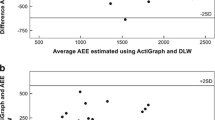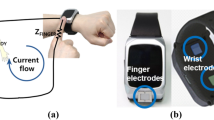Abstract
Purpose
Overweight and obesity are increasing among Italian children, particularly due to sedentary lifestyle. The evaluation of daily energy expenditure (EE) is therefore relevant to assess the level of physical activity in subjects at risk. Portable devices could improve the free-living EE monitoring, provided they are properly calibrated and validated. The present study aimed at evaluating a new multisensor wrist monitor (WM) (E3®, Empatica srl, Italy) in EE assessment in obese children and adolescents.
Methods
Twenty-eight participants (15 males; age 13 ± 2 years; mean ± SD) were enrolled. Nineteen subjects were obese (body mass index (BMI) >95th percentile for age and sex). Subjects were tested (1) while sitting (SIT), and during (2) walking at comfortable speed (SS) and (3) at faster speed (FS). EE was assessed in each condition by both indirect calorimetry (IC, by oxygen consumption measurement) and multisensor (accelerometry, heart rate, skin galvanic reaction, temperature) methods.
Results
EE measured during SIT, SS and FS was 1.48 ± 0.31, 4.25 ± 0.68 and 5.64 ± 0.92 METs with IC and 1.19 ± 0.11, 3.82 ± 0.77 and 5.17 ± 0.81 METs with WM, respectively. A significant difference (P < 0.01) between measurement methods in SS and FS condition (pooled data) disappeared in obese individual subgroup. The linear regression coefficient between EEs obtained by the two methods was 0.79 (P < 0.05), and the Bland–Altman plot showed a proportional bias.
Conclusions
EE estimated by the multisensor wrist monitor highly correlated with the values obtained by IC, particularly in the subgroup of obese children and adolescents, suggesting that it can be used to monitor physical activity in this specific population.





Similar content being viewed by others
Abbreviations
- BMI:
-
Body mass index
- EE:
-
Energy expenditure
- IC:
-
Indirect calorimetry
- MET:
-
Metabolic equivalent (=3.5 mlO2 min−1 kg−1)
- NW:
-
Normal weight
- OW:
-
Obese
- WM:
-
Wrist monitor
References
Micciolo R, Di Francesco V, Fantin F, Canal L, Harris TB, Bosello O, Zamboni M (2010) Prevalence of overweight and obesity in Italy (2001–2008): is there a rising obesity epidemic? Ann Epidemiol 20(4):258–264. doi:10.1016/j.annepidem.2010.01.006
Wijnhoven TM, van Raaij JM, Spinelli A, Rito AI, Hovengen R, Kunesova M, Starc G, Rutter H, Sjoberg A, Petrauskiene A, O’Dwyer U, Petrova S, Farrugia Sant’angelo V, Wauters M, Yngve A, Rubana IM, Breda J (2013) WHO European Childhood Obesity Surveillance Initiative 2008: weight, height and body mass index in 6–9-year-old children. Pediatr Obes 8(2):79–97. doi:10.1111/j.2047-6310.2012.00090.x
Turchetta F, Gatto G, Saulle R, Romano F, Boccia A, La Torre G (2012) Systematic review and meta-analysis of the prevalence of overweight and obesity among school-age children in Italy. Epidemiol Prev 36(3–4):188–195
Rendo-Urteaga T, de Moraes AC, Collese TS, Manios Y, Hagstromer M, Sjostrom M, Kafatos A, Widhalm K, Vanhelst J, Marcos A, Gonzalez-Gross M, De Henauw S, Ciarapica D, Ruiz JR, Espana-Romero V, Molnar D, Carvalho HB, Moreno LA (2015) The combined effect of physical activity and sedentary behaviors on a clustered cardio-metabolic risk score: the Helena study. Int J Cardiol 186:186–195. doi:10.1016/j.ijcard.2015.03.176
Kimm SY, Glynn NW, Obarzanek E, Kriska AM, Daniels SR, Barton BA, Liu K (2005) Relation between the changes in physical activity and body-mass index during adolescence: a multicentre longitudinal study. Lancet 366(9482):301–307. doi:10.1016/S0140-6736(05)66837-7
Van Hulst A, Roy-Gagnon MH, Gauvin L, Kestens Y, Henderson M, Barnett TA (2015) Identifying risk profiles for childhood obesity using recursive partitioning based on individual, familial, and neighborhood environment factors. Int J Behav Nutr Phys Act 12(1):17. doi:10.1186/s12966-015-0175-7
Hobbs M, Pearson N, Foster PJ, Biddle SJ (2014) Sedentary behaviour and diet across the lifespan: an updated systematic review. Br J Sports Med. doi:10.1136/bjsports-2014-093754
Raask T, Konstabel K, Maestu J, Latt E, Jurimae T, Jurimae J (2015) Tracking of physical activity in pubertal boys with different BMI over two-year period. J Sports Sci. doi:10.1080/02640414.2015.1012097
Ainsworth B, Cahalin L, Buman M, Ross R (2015) The current state of physical activity assessment tools. Prog Cardiovasc Dis 57(4):387–395. doi:10.1016/j.pcad.2014.10.005
Bailey RC, Olson J, Pepper SL, Porszasz J, Barstow TJ, Cooper DM (1995) The level and tempo of children’s physical activities: an observational study. Med Sci Sports Exerc 27(7):1033–1041
Intille SS, Lester J, Sallis JF, Duncan G (2012) New horizons in sensor development. Med Sci Sports Exerc 44(1 Suppl 1):S24–S31. doi:10.1249/MSS.0b013e3182399c7d
Lubans DR, Hesketh K, Cliff DP, Barnett LM, Salmon J, Dollman J, Morgan PJ, Hills AP, Hardy LL (2011) A systematic review of the validity and reliability of sedentary behaviour measures used with children and adolescents. Obes Rev 12(10):781–799. doi:10.1111/j.1467-789X.2011.00896.x
Calabro MA, Lee JM, Saint-Maurice PF, Yoo H, Welk GJ (2014) Validity of physical activity monitors for assessing lower intensity activity in adults. Int J Behav Nutr Phys Act 11(1):119. doi:10.1186/s12966-014-0119-7
Froberg A, Raustorp A (2014) Objectively measured sedentary behaviour and cardio-metabolic risk in youth: a review of evidence. Eur J Pediatr 173(7):845–860. doi:10.1007/s00431-014-2333-3
Puyau MR, Adolph AL, Vohra FA, Butte NF (2002) Validation and calibration of physical activity monitors in children. Obes Res 10(3):150–157. doi:10.1038/oby.2002.24
Fruin ML, Rankin JW (2004) Validity of a multi-sensor armband in estimating rest and exercise energy expenditure. Med Sci Sports Exerc 36(6):1063–1069
Schmitz KH, Treuth M, Hannan P, McMurray R, Ring KB, Catellier D, Pate R (2005) Predicting energy expenditure from accelerometry counts in adolescent girls. Med Sci Sports Exerc 37(1):155–161
Krebs NF, Himes JH, Jacobson D, Nicklas TA, Guilday P, Styne D (2007) Assessment of child and adolescent overweight and obesity. Pediatrics 120(Suppl 4):S193–S228. doi:10.1542/peds.2007-2329D
Kuczmarski RJ, Ogden CL, Grummer-Strawn LM, Flegal KM, Guo SS, Wei R, Mei Z, Curtin LR, Roche AF, Johnson CL (2000) CDC growth charts: United States. Adv Data 314:1–27
Dutra GF, Kaufmann CC, Pretto AD, Albernaz EP (2015) Television viewing habits and their influence on physical activity and childhood overweight. J Pediatr (Rio J). doi:10.1016/j.jped.2014.11.002
LeBlanc AG, Broyles ST, Chaput JP, Leduc G, Boyer C, Borghese MM, Tremblay MS (2015) Correlates of objectively measured sedentary time and self-reported screen time in Canadian children. Int J Behav Nutr Phys Act 12(1):38. doi:10.1186/s12966-015-0197-1
Kettner S, Kobel S, Fischbach N, Drenowatz C, Dreyhaupt J, Wirt T, Koch B, Steinacker JM (2013) Objectively determined physical activity levels of primary school children in south-west Germany. BMC Public Health 13:895. doi:10.1186/1471-2458-13-895
Katzmarzyk PT, Barreira TV, Broyles ST, Champagne CM, Chaput JP, Fogelholm M, Hu G, Johnson WD, Kuriyan R, Kurpad A, Lambert EV, Maher C, Maia J, Matsudo V, Olds T, Onywera V, Sarmiento OL, Standage M, Tremblay MS, Tudor-Locke C, Zhao P, Church TS (2015) Physical activity, sedentary time, and obesity in an international sample of children. Med Sci Sports Exerc. doi:10.1249/MSS.0000000000000649
Lanningham-Foster L, Jensen TB, Foster RC, Redmond AB, Walker BA, Heinz D, Levine JA (2006) Energy expenditure of sedentary screen time compared with active screen time for children. Pediatrics 118(6):e1831–e1835. doi:10.1542/peds.2006-1087
Cliff DP, Reilly JJ, Okely AD (2009) Methodological considerations in using accelerometers to assess habitual physical activity in children aged 0–5 years. J Sci Med Sport 12(5):557–567. doi:10.1016/j.jsams.2008.10.008
Pate RR, Pratt M, Blair SN, Haskell WL, Macera CA, Bouchard C, Buchner D, Ettinger W, Heath GW, King AC et al (1995) Physical activity and public health. A recommendation from the Centers for Disease Control and Prevention and the American College of Sports Medicine. JAMA 273(5):402–407
Acknowledgments
We thank all the subjects and families for their patience and courtesy, Dr. G. Colella and Dr. D. David for their assistance in data collection, and Ing. Maurizio Garbarino for the technical assistance. The study was supported by a grant of “Fondazione Romeo ed Enrica Invernizzi”.
Author information
Authors and Affiliations
Corresponding author
Ethics declarations
Conflict of interest
The authors report no conflict of interest.
Ethical approval
All procedures performed in studies involving human participants were in accordance with the ethical standards of the institutional and/or national research committee and with the 1964 Helsinki declaration and its later amendments or comparable ethical standards.
Informed consent
Informed consent was obtained from all individual participants included in the study.
Rights and permissions
About this article
Cite this article
Rampichini, S., Merati, G., Mameli, C. et al. Energy expenditure in obese children: evaluation of a new multisensor device. Sport Sci Health 11, 305–312 (2015). https://doi.org/10.1007/s11332-015-0241-1
Received:
Accepted:
Published:
Issue Date:
DOI: https://doi.org/10.1007/s11332-015-0241-1




